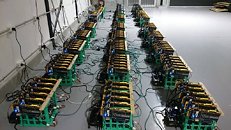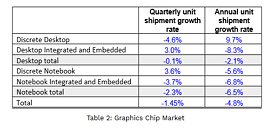Raevenlord
News Editor
- Joined
- Aug 12, 2016
- Messages
- 3,755 (1.21/day)
- Location
- Portugal
| System Name | The Ryzening |
|---|---|
| Processor | AMD Ryzen 9 5900X |
| Motherboard | MSI X570 MAG TOMAHAWK |
| Cooling | Lian Li Galahad 360mm AIO |
| Memory | 32 GB G.Skill Trident Z F4-3733 (4x 8 GB) |
| Video Card(s) | Gigabyte RTX 3070 Ti |
| Storage | Boot: Transcend MTE220S 2TB, Kintson A2000 1TB, Seagate Firewolf Pro 14 TB |
| Display(s) | Acer Nitro VG270UP (1440p 144 Hz IPS) |
| Case | Lian Li O11DX Dynamic White |
| Audio Device(s) | iFi Audio Zen DAC |
| Power Supply | Seasonic Focus+ 750 W |
| Mouse | Cooler Master Masterkeys Lite L |
| Keyboard | Cooler Master Masterkeys Lite L |
| Software | Windows 10 x64 |
The title of this piece is both question and answer, though users that keep up with PC-related news knew the answer already. Jon Peddie Research, in a new report, pegs the number of total graphics cards sold to miners at a pretty respectable 3 million units (worth some $776 million). That's some 3 million gamers that could be enjoying video games on their PCs right now, or which would be able to enjoy them at a much lower price that they had to recently pay to have the privilege.
AMD has been the primary benefactor here - its GPU market share went up by 8.1%, while NVIDIA's dropped by 6% and Intel's by 1.9% (the fact that Intel's graphics processing units come embedded in the company's processors helps keep that number stable). As it is, attachment rates of GPUs to systems was over 100% at 136%, the result of miners buying more cards per system in an effort to maximize profits. Jon Peddie thinks that gaming will still be the key player to drive GPU sales, though "augmented by the demand from cryptocurrency miners." The firm also expects demand for GPUs to slacken, coeteris paribus, due to "increasing utilities costs and supply and demand forces that drive up AIB prices." However, for those looking for prices to drop before upgrading their system, the news aren't rosy: the article states that pricing will not drop in the foreseeable future, so owners of GPUs that can actually mine already are being encouraged to mine while not gaming, so as to try and offset the markups in the current GPU offerings.


Overall GPU shipments in the fourth quarter of 2017 actually decreased 1.5% from the previous quarter, though JPR said that was due to normal seasonal activity. But even with miners' help to drive sales, overall GPU market shipments declined 4.8 percent - the only actual positive trend in that market were the actual discrete desktop GPUs.


Some key highlights JPR calls attention to are as follows:
View at TechPowerUp Main Site
AMD has been the primary benefactor here - its GPU market share went up by 8.1%, while NVIDIA's dropped by 6% and Intel's by 1.9% (the fact that Intel's graphics processing units come embedded in the company's processors helps keep that number stable). As it is, attachment rates of GPUs to systems was over 100% at 136%, the result of miners buying more cards per system in an effort to maximize profits. Jon Peddie thinks that gaming will still be the key player to drive GPU sales, though "augmented by the demand from cryptocurrency miners." The firm also expects demand for GPUs to slacken, coeteris paribus, due to "increasing utilities costs and supply and demand forces that drive up AIB prices." However, for those looking for prices to drop before upgrading their system, the news aren't rosy: the article states that pricing will not drop in the foreseeable future, so owners of GPUs that can actually mine already are being encouraged to mine while not gaming, so as to try and offset the markups in the current GPU offerings.


Overall GPU shipments in the fourth quarter of 2017 actually decreased 1.5% from the previous quarter, though JPR said that was due to normal seasonal activity. But even with miners' help to drive sales, overall GPU market shipments declined 4.8 percent - the only actual positive trend in that market were the actual discrete desktop GPUs.


Some key highlights JPR calls attention to are as follows:
- AMD's overall unit shipments increased 8.08% quarter-to-quarter, Intel's total shipments decreased -1.98% from last quarter, and Nvidia's decreased -6.00%.
- The attach rate of GPUs (includes integrated and discrete GPUs) to PCs for the quarter was 134% which was down -10.06% from last quarter.
- Discrete GPUs were in 36.88% of PCs, which is down -2.67%.
- The overall PC market increased 5.93% quarter-to-quarter, and decreased -0.15% year-to-year.
- Desktop graphics add-in boards (AIBs) that use discrete GPUs decreased -4.62% from last quarter.
- Q4'17 saw no change in tablet shipments from last quarter.
View at TechPowerUp Main Site






